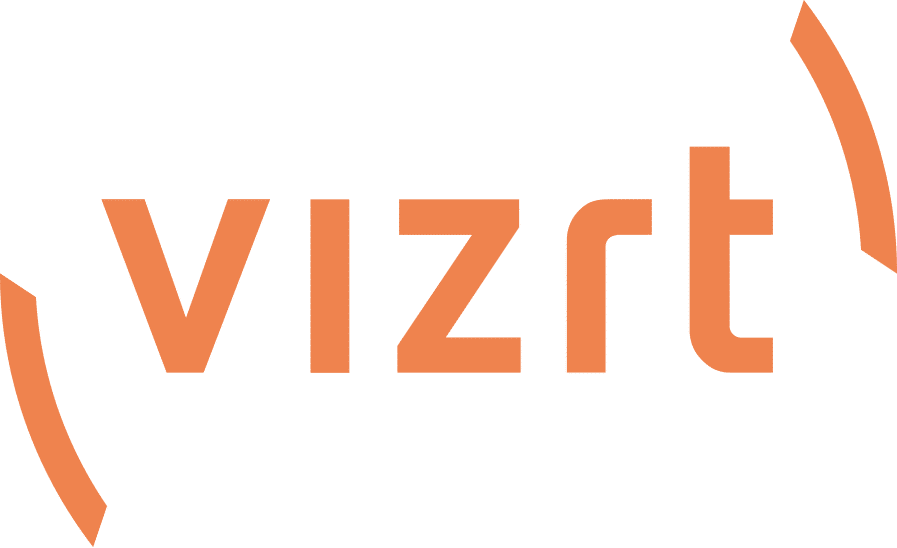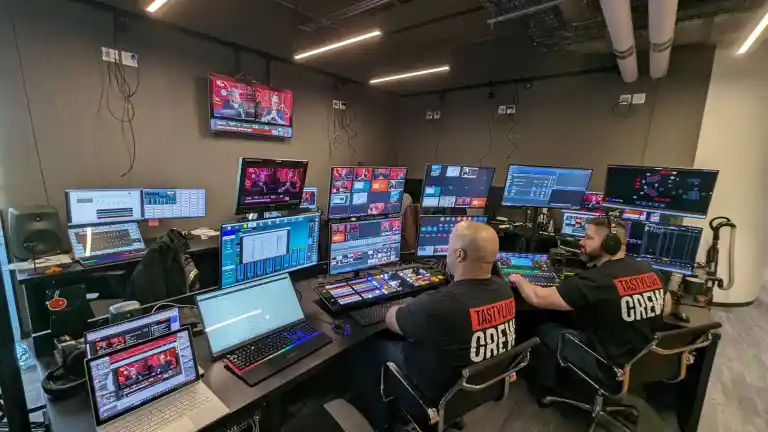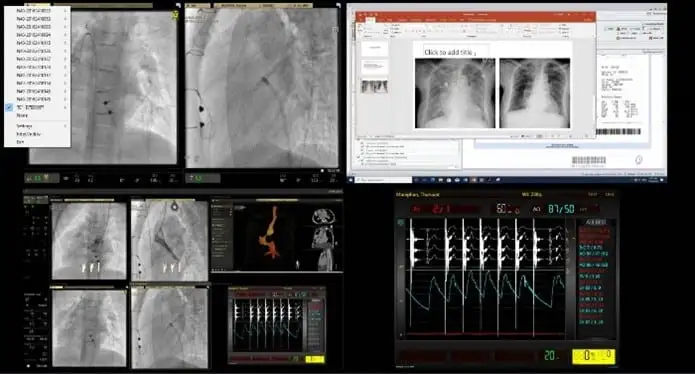The Medford School District in Southern Oregon serves 14,444 students across a broad geographical area – reaching as far south as the California border and covering some of Oregon’s smallest rural communities. And just like every other district in March of 2020 the Medford School District had to shut its doors to students as a result of the COVID-19 global pandemic.
For many across the world the abrupt closure resulted in an incredibly challenging end to the school year. Efforts to pivot to digital learning spaces were swiftly taken up, but largely mimicked the corporate world of virtual meetings. Computer screens filled with dozens of talking heads became common – a far cry from an ideal learning environment.
Medford, however, was in a unique position. A partnership between the district and local broadcaster Southern Oregon PBS had been developed earlier in the school year. As part of the relationship, students were engaging in robust broadcast coursework. And at the technological core of the curriculum was a NewTek TriCaster.
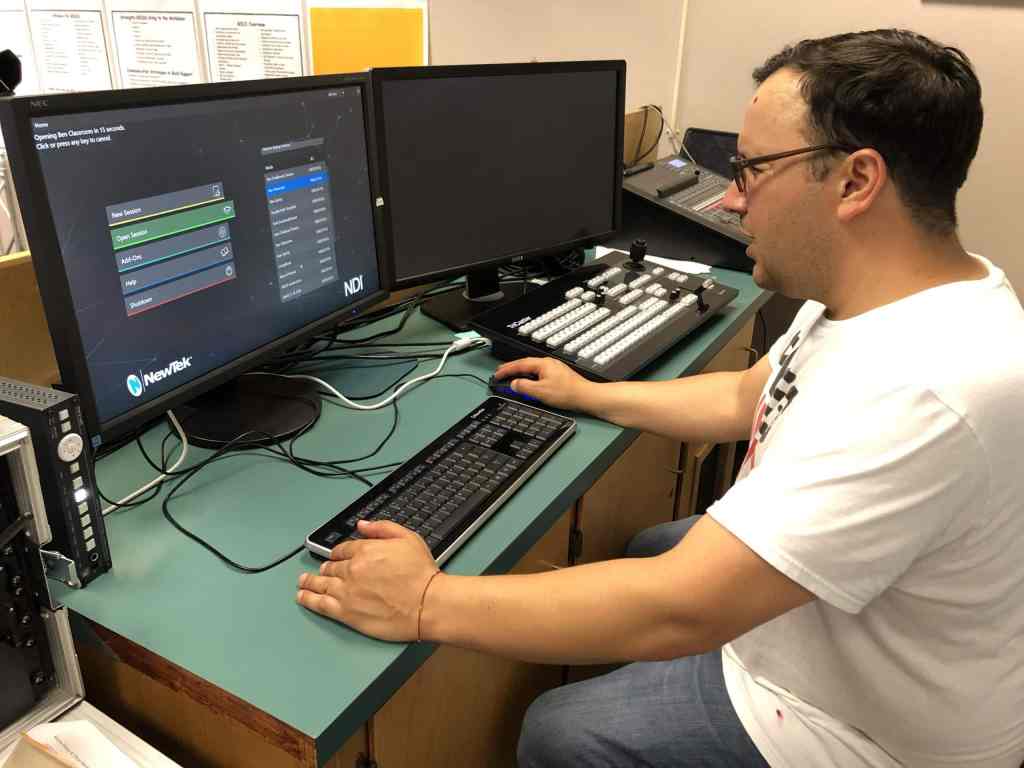
Ben Garcia, Education Coordinator at Southern Oregon PBS, operates the TriCaster in the Medford Anywhere Learning TV studio. Even though the videos aren’t broadcast live, the TriCaster allows for live switching, which drastically reduces post-production, and allows the studio to put out more content
The TriCaster is a live production system that offers powerful and affordable tools to video producers and visual storytellers. With cutting edge video production capabilities, the TriCaster enables everyone – from individual creators and small-to-medium sized enterprises, to major studios, broadcasters, and large-scale campuses – to harness the power of professional grade video.
When coupled with the free-to-use NDI technology, which eliminates costly cable runs, the TriCaster solution allows for swift and elegant production without the need for a large staff on site.
So, when schools closed, an opportunity presented itself in Medford. The district’s broadcast space – a former band and multipurpose room – sat empty. It was a large enough room that social distancing could still be maintained among a small group – a group that could take on the production of custom content for students.
Thus, a plan was put in place to not just go online with classes, but to truly expand coursework utilizing engaging video.
New types of content
“When the pandemic hit we were immediately asked what we could do,” said Ben Garcia, Education Coordinator at Southern Oregon PBS and one of the leading lights behind the production. “There was an immediate belief that we had the tools in place to develop a model where teachers wouldn’t just be on conference calls all day, but rather, developing content that could engage with their students.”

Middle school teacher Ivan Ohlinghaus discusses the district’s pivot to video from the studio space – a converted multipurpose and music room in one of the middle schools in Medford, Oregon
Thus, Medford Anywhere Learning TV was formed. Teachers would enter the production studio on a set schedule, record their lessons using creative video elements, and add the content to their weekly instruction. This was seen as especially crucial in the kindergarten to third grade space, where video conferencing was a particular challenge.
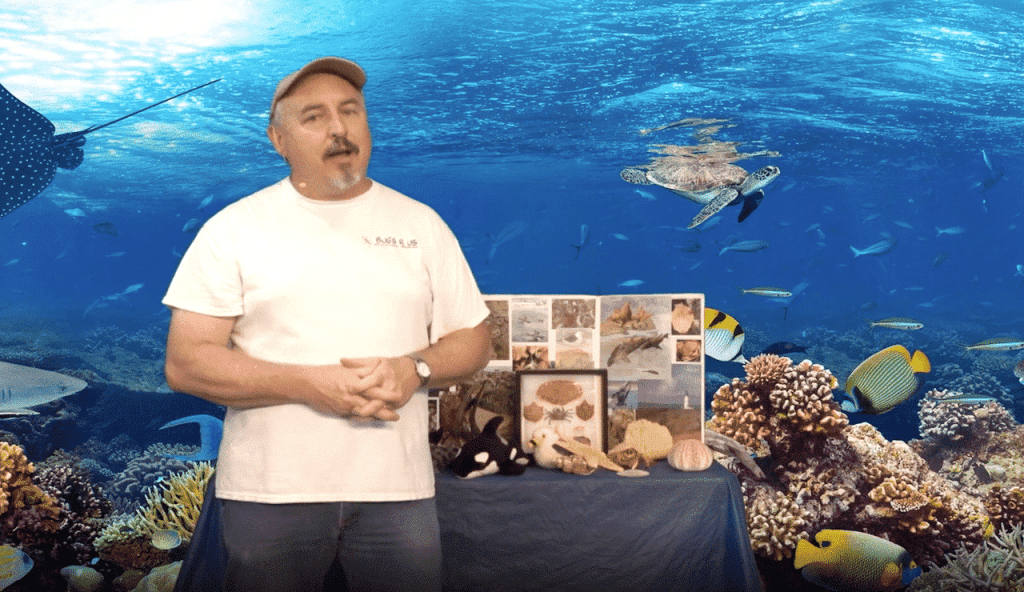
John Jackson of BUGS-R-US Educational Services offers up an underwater biology lesson on Medford Anywhere Learning TV
That said, the amount of content that would need to be edited was daunting. A plan needed to be put in place that allowed for swift production times – thus giving teachers a true asset to plan for in the coming week.
The key, Garcia said, was the TriCaster. While the production wouldn’t be going immediately live with the video, the camera switching and graphic work was still done in real time. This drastically cut down on post production while still allowing for creative elements – multicamera production, greenscreen, and live graphics – to be utilized in the videos.
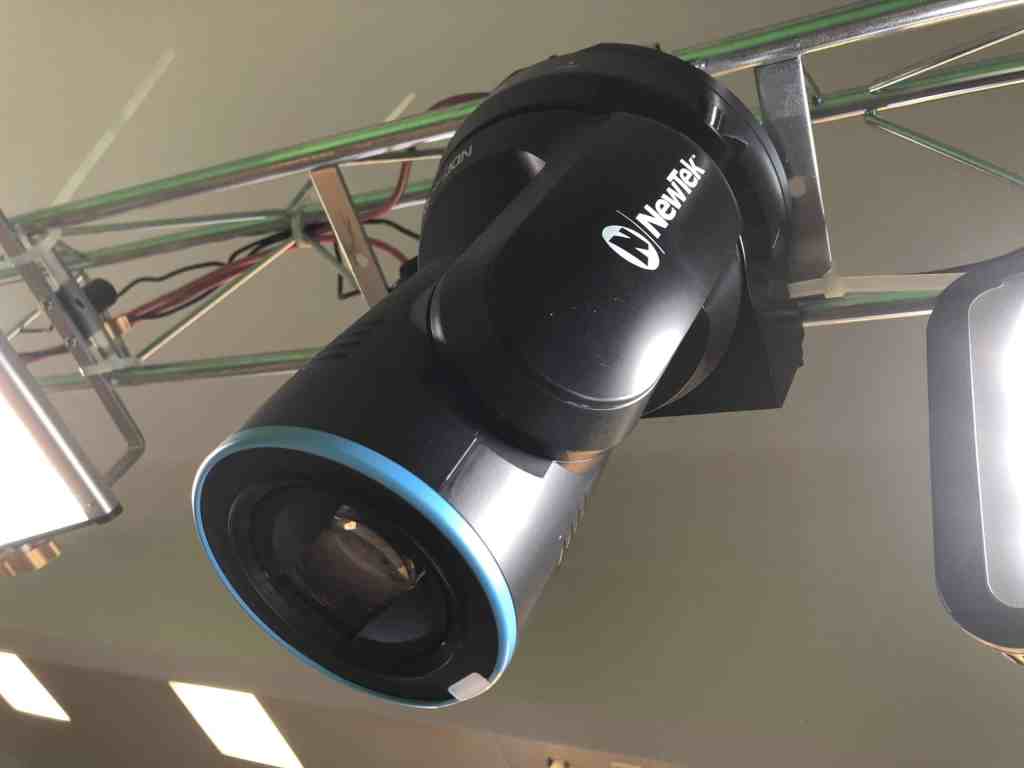
Medford Anywhere Learning TV has multiple NewTek PTZ cameras set up – including ones mounted to overhead truss work. This allows for shots to look down at projects teachers may be working at from the desk
“What we found immediately was that all the teachers loved it,” Garcia said. “It was a simple and impressive way for them to add to the curriculum. It added a level of interactivity to the school year, and the feedback from the students and parents watching it was the same: they loved it too.”
Reaching out to students
Medford School District Superintendent Bret Champion said this approach to distance learning – crafting video content as opposed to just using virtual meeting software – allowed educators to reach a bit further than virtual classroom lessons would. That’s because three of the local broadcast stations in Southern Oregon agreed to air content in the morning hours of the day.
“The thing that set us apart was we had this opportunity for our kids with just an antenna to be able to see their teacher on TV,” Champion said. “[There were] a lot of fun learning opportunities for our students.”
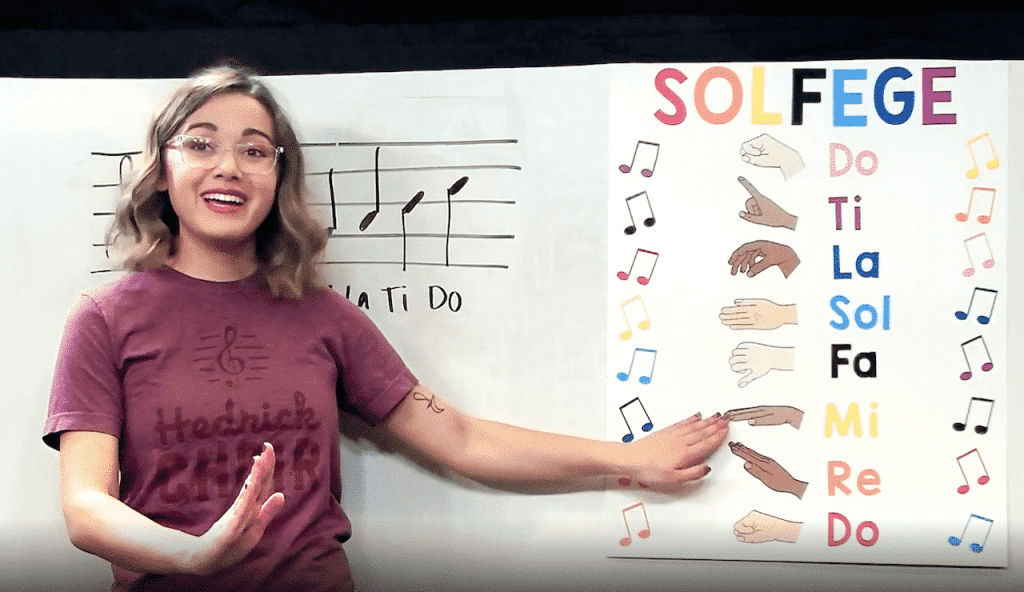
Danika Locey teaches Middle School Choir as part of Medford Anywhere Learning TV
Homelessness in the district is roughly 10 percent. Another group of students live so far into the Applegate Valley that internet access is either unreliable or nonexistent. Simply put: not everyone can log on to a computer every day.
“But we can send out video lessons via television or through flash drives that work with their district Chromebooks,” said Ivan Ohlinghaus, middle school teacher and one of the key creative forces behind the shift to video. “That was obviously far more engaging for students than if we just recorded a video conference call. It was a television show. It is real, educational, entertaining content.”
Further, because of the quick production time, the content could be provided rapidly and reliably to television stations and students.
“The week after spring break we set it all up,” said Ben Garcia. “Then we hit the ground running. We filmed 15 lesson plans in our first full week of production and sent those to the stations.”
Making the grade
Teachers in the district immediately found the ability to provide a dynamic lesson to students to be a critical component of the new normal in their pedagogy.
“I think this has really opened a lot of eyes to the opportunity [of video content],” said Kristen Robinson, kindergarten teacher at the district. “We can offer a dual learning situation where kids don’t necessarily have to go to a brick and mortar school to get what they need from their teachers. They can stay home and click and have supplemental learning.”
The district also connected with Kid Time Children’s Museum, a local provider of preschool in the Medford area, and asked if they would like to take part in the project. The teachers as the school jumped at the opportunity.

Preschool teachers Britt Zimmerman (left) and Connor Reese (right) utilize virtual sets (and a black and white aesthetic) to create a mystery episode
“Preschool isn’t about academics,” said Britton Zimmerman, teacher and director of Kid Time Children Museum. “It’s all about connection and relationships and social-emotional components. So if we can’t see [the kids] how can we keep that connection?”

Preschool teacher Xane Buckingham flies into screen with the help of TriCaster production elements
The answer was to keep the teachers the kids were familiar with in their lives by putting them on screen. A black and white mystery episode was filmed. Teachers were flying into the cityscape. Guitars and music were being played.
Far reaching results
The episodes were also made available on YouTube for free – resulting in messages coming in from as far out as Chicago and New York with thanks for the content.
Champion said that feedback – be it from parents in the district or from across the country – is critical in how they will approach the continued need to provide distance learning going forward.
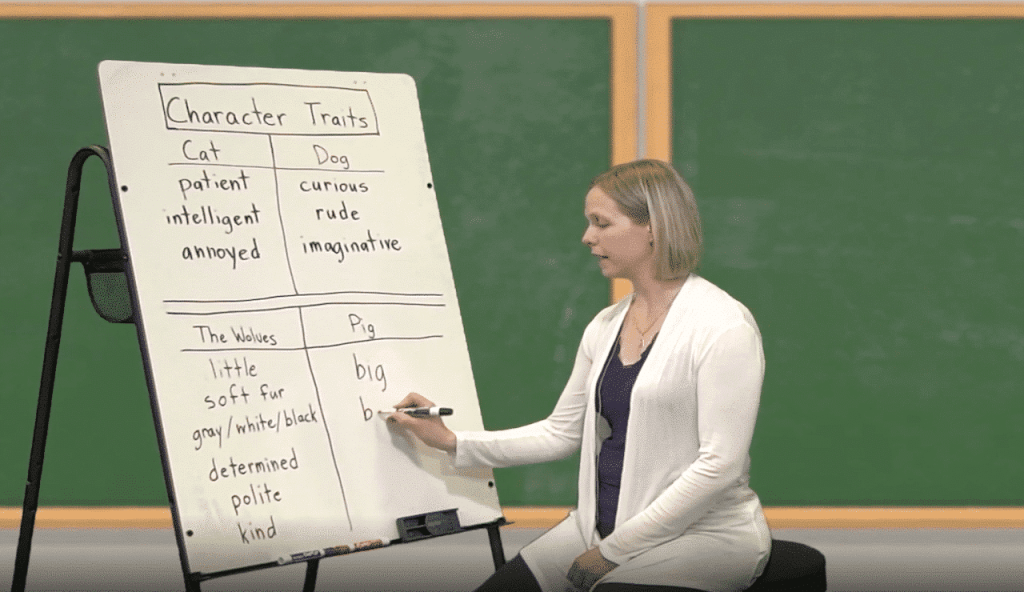
Kristin Schmidt, first and second grade teacher, uses real-life elements (the whiteboard) and digital elements, such as the virtual background that emulates a classroom environment
“Parents are interested in choice,” Champion said. “What they are now looking for is ‘here are some options’ [and they decide] what makes most sense for their kid. I believe if you are looking for long term sustainability, and keeping folks engaged, you need to have a product that is able to have multiple views and different angles and things that us laymen people don’t know that magic that’s actually happening – but we know it’s not some simple cell phone that’s recording the thing.”

Fourth grade teacher Tracy Titus (right) talks with The Wolf from a children’s a story (played by first grade teacher Zoey Boyles)
Robinson said the quality of the programming leaves her optimistic of the year to come, regardless of the teaching model.
“My hope is we are all back in our classrooms,” Robinson said. “That is where my heart longs to be. But the gift of all of this has been so monumental that if we had to return to this, I would do it in a heartbeat.”
Learn more about:
